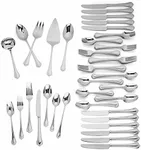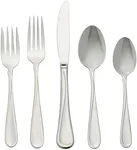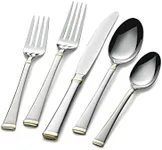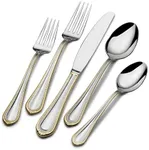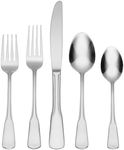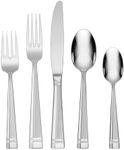Buying Guide for the Best Flatware Sets
Choosing the right flatware set can make everyday meals more enjoyable and add a touch of style to your dining table. When shopping for flatware, it's important to consider not just the look, but also the feel, durability, and practicality of the pieces. Think about how many people you usually serve, how often you entertain guests, and whether you prefer something classic or modern. By understanding the key features of flatware, you can find a set that fits your lifestyle and complements your tableware.MaterialMaterial refers to what the flatware is made from, and it's a crucial factor because it affects durability, appearance, and maintenance. The most common materials are stainless steel, silver-plated, and sometimes plastic or bamboo for casual use. Stainless steel is popular for its resistance to rust and ease of care, and it comes in different grades, like 18/10, 18/8, and 18/0, which indicate the amount of chromium and nickel for shine and strength. Silver-plated flatware offers a more traditional, elegant look but requires more upkeep to prevent tarnishing. If you want something for everyday use, stainless steel is usually the best choice, while silver-plated or decorative materials might be better for special occasions.
Number of PiecesThe number of pieces in a flatware set tells you how many utensils are included and for how many people. Sets can range from service for four (usually 20 pieces) to service for twelve or more. Some sets include only the basics—forks, knives, and spoons—while others add serving utensils or specialty pieces. If you have a small household or rarely host guests, a smaller set may be enough. For larger families or frequent entertaining, a bigger set ensures everyone has matching utensils and you won't run out during meals.
Weight and BalanceWeight and balance describe how heavy the flatware feels in your hand and how evenly it is distributed. Heavier flatware often feels more substantial and can be more comfortable to use, while lighter pieces may be easier for children or elderly family members. The right balance means the utensils don't tip or feel awkward when you hold them. When choosing, think about who will use the flatware most often and whether you prefer a solid, weighty feel or something lighter and easier to handle.
Design and FinishDesign and finish refer to the style and surface treatment of the flatware. Designs range from simple and modern to ornate and traditional, and finishes can be shiny, matte, or even colored. The design you choose should match your personal taste and the style of your dinnerware. A classic, plain design is versatile and timeless, while a decorative pattern can add flair to special occasions. Consider how the flatware will look with your plates and whether you want it to stand out or blend in.
Dishwasher CompatibilityDishwasher compatibility means whether the flatware can be safely cleaned in a dishwasher without damage. Most modern stainless steel flatware is dishwasher safe, making cleanup easy, but some finishes or materials (like silver-plated or gold-accented pieces) may require hand washing to maintain their appearance. If convenience is important to you and you use a dishwasher regularly, make sure the set you choose is labeled as dishwasher safe.
ErgonomicsErgonomics is about how comfortable the flatware is to hold and use. Some handles are shaped for a better grip, while others may be too thin or too thick for certain hands. If you have young children, elderly family members, or anyone with grip issues, look for flatware with handles that are easy to hold and not too slippery. Testing how the utensils feel in your hand can help you pick a set that everyone in your household will find comfortable.





